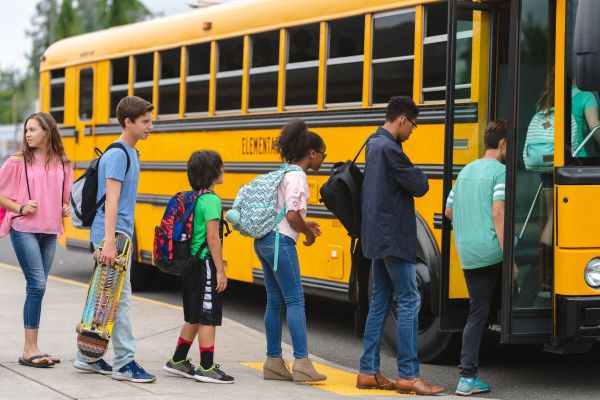The American school system
Are you planning to immigrate to the USA with children of school age? We explain how the American school system works and explore the advantages, possibilities, and costs.
- Age groups and types of schools in the USA
- Kindergarten
- Elementary school or primary school
- Middle school or junior high school
- High school
- College or university
- Benefits of the American school system
- Flexible timetable
- Modern equipment
- Cost of the American school system
- Enrollment in a US school as an immigrant
- FAQ
Take the chance of living in the USA and apply for the official US Green Card Lottery!
Age groups and types of schools in the USA
In the USA, school attendance is compulsory. Depending on the state, education begins between the ages of five and eight and ends between the ages of 16 and 18. The age at which students change from one type of school to another varies from state to state and school district to school district. Broadly speaking, the US school system consists of the following types of schools:
Kindergarten
Kindergarten in America is attended from the age of three to four. Depending on where you live, care is provided on a half-day or full-day basis. Instruction is not oriented toward play but is led by trained teachers who provide children with their first skills in reading and calculating. Public kindergartens can be attended free of charge in the USA. In 15 US states, attendance is mandatory.
Elementary school or primary school
American children attend elementary school from the age of five or six. In elementary school, also known as primary school, they learn basic skills such as reading, writing, and mathematics. Their performance is evaluated with grades for the first time here.
How long a child attends elementary or primary school depends on the state and the school district. Depending on the educational model used, students usually attend this type of school for four to six years.
In some places, students stay in elementary school for eight years. These students do not attend middle or junior high school and transfer directly to high school at the age of 13 or 14.

Middle school or junior high school
Students who graduate from elementary school between the ages of nine and eleven go on to middle school or junior high school.
The difference between the two types of schools is the educational concept. While middle school focuses more on teamwork and the development of social skills, junior high school is more performance-oriented and focuses strongly on academic education.
Within both types of school, students who are strong learners and those who are less strong learners are not separated from one another but are always taught in the same classroom.
High school
At age 13 or 14, American students begin their high school years. Just like middle and junior high school, high school is a uniform school where the performance level of the students is mixed within a class.
During the four-year high school phase, young people in America benefit from a course system in which they take some required subjects but can also attend individually chosen courses.
Each of the four high school years is concluded with final exams. After completing the twelfth grade, the young people receive their High School Diploma, which entitles them to study at a college or university. At this point, however, they can also leave the American school system and enter the workforce.
College or university
MIT, Harvard, Stanford, Yale, Columbia & Co.: The USA alone is home to 12 of the top 25 universities in the world. The high quality of the renowned universities and their research facilities is known far beyond the borders of the United States.
University education has a very high status in the American school system. Those who graduate from university are in demand in the job market. Accordingly, a large number of young adults choose to study in the USA every year.
On a side note, the admissions process for a university in the US can be quite difficult. Depending on the institution as well as its prestige and the number of applicants, there are sometimes challenging entrance exams that must be taken. Letters of recommendation from high school teachers are also sometimes required.

Benefits of the American school system
The American school system has many advantages and an excellent reputation worldwide. American schools have the following special features:
Flexible timetable
American schools are usually full-day schools, where children are busy with classes and extracurricular activities from morning to night.
A wide range of subjects is available to students at high schools. In addition to the required subjects of English, math, geography, social studies, and history, they can choose from many educational opportunities. A counselor assists students in putting together the best schedule.
In addition to regular classes, students can pursue extracurricular activities in the afternoons according to their interests and talents. Sports such as American Football, basketball, and cheerleading are very popular, but so are creative activities such as theater club or school choir.
Modern equipment
One of the great advantages of the American school system is the high quality of its facilities. Schools and universities in the USA are known for their modern classrooms, libraries, laboratories, and sports venues.

Cost of the American school system
Public schools in the USA are free for children and young people up to the age of 21. Books are also generally provided free of charge. However, teaching materials such as pads and pencils must be purchased by the student. Fees are also sometimes charged for events, school trips, or extracurricular activities.
Around 90 % of school-age children in the USA take advantage of the educational opportunities offered by state-run public schools. However, there are also private schools in the American school system that have to be financed by the parents themselves. Parents who value education in a private school must - depending on the school - expect costs between $ 4,000 and $ 30,000 per year and child.
High tuition fees are also charged at American colleges and universities, with large price differences from college to college. You can get a rough overview of the costs you can expect for your chosen course of study with the help of the College Affordability and Transparency Center of the U.S. Department of Education.
Tip: Green Card holders pay up to 80 % less tuition fees at American universities than international students. If you don't have a Green Card, but you know that you want to study in the USA, it is worth participating in the Green Card Lottery, in which the US authorities raffle off 55,000 of the popular Green Cards every year to participants from all over the world.
Enrollment in a US school as an immigrant
As an immigrant in the United States, you must enroll your school-age children in a school as soon as possible. To do so, contact the school district that serves your area of residence.
The school district will assign your child to an appropriate school. The latter will then place your child in the right class. If your child does not speak enough English, the US government will assist with bilingual education or courses such as "English as a Second Language (ESL)." However, regardless of their English proficiency, your child must learn the subjects taught at their grade level.
You will need the following documents to enroll your child in an American school:
- Passport or birth certificate
- Proof of residency (e.g., driver's license, rental agreement, tax return, utility bill)
- Immunization record (required immunizations vary from school to school)
- Results of a medical examination, including a tuberculosis test
- Social Security Card, if applicable
Do you still have questions about the American school system? Then you're sure to find the answer in our FAQ.
Children from about six weeks to four or five years of age can attend a preschool or daycare center (also known as a nursery school) in the USA. Supervision is available on a half-day or full-day basis. Since children at this young age are not yet of compulsory school age, a fee is usually charged for daycare centers and preschools.
Most American schools do not require students to wear uniforms. However, there is usually a strict dress code that students must adhere to. "No-go's" at many schools include:
- Showing a lot of bare skin (e.g., belly tops, large necklines, thin shoulder straps, halter tops)
- Shirts with prints that glorify violence, drugs, or alcohol
- Slippers or flip flops
- Caps, hats, bonnets, and other head coverings (must be removed inside the school building)
If possible, children with disabilities are placed in a regular class at a public school. Education is also free of charge for them. It is only when a child's disability is severe that they receive special tuition outside of the regular classroom.
The abbreviation GED stands for General Education Diploma (GED). Young people who have not earned a high school diploma by age 21 can get their certificate by taking a GED test. The test is taken in four subjects (languages, math, social studies, and science) and costs between $ 15 and $ 160, depending on the state.


 DE
DE EN
EN ES
ES FR
FR IT
IT PL
PL TR
TR UA
UA